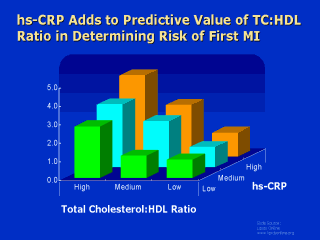 |
From a clinical
perspective, the best way to understand these data is to use our best lipid marker, the
total cholesterol:HDL cholesterol ratio, and simultaneously assess the hs-CRP level. In
another analysis from the Physicians' Health Study, there is a clear interaction between
the hs-CRP levels and the total cholesterol:HDL cholesterol ratio, indicating that using
both these parameters appears to do a better job of predicting risk than using either
alone. These data are also important at another level. Current recommendations for primary
prevention focus largely on lipid screening, which is highly effective in detecting
individuals at risk. However, as shown in this slide, there are many individuals with
moderate cholesterol levels who nonetheless are at high risk and might have been
identified with combined CRP and cholesterol screening. Reference:
Ridker PM, Glynn RJ, Hennekens CH. C-reactive protein adds to the predictive value of
total and HDL cholesterol in determining risk of first myocardial infarction. Circulation
1998;97:2007-2011.
WebsiteRier PM et al. Circulation
1998;97:2007-2011.a 1998 Lippincott Williams & Wilkins. |
